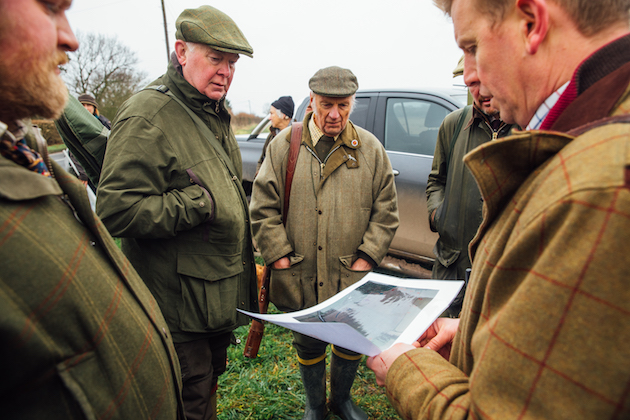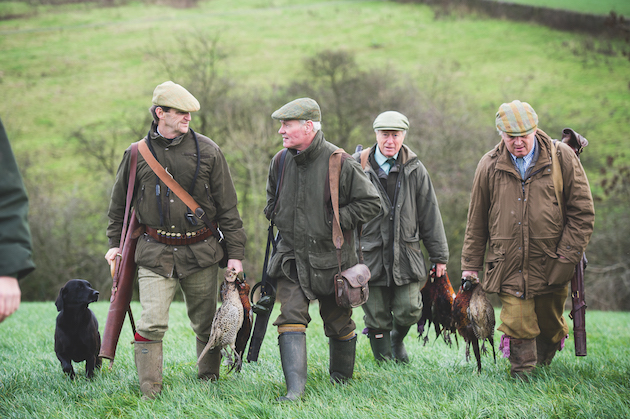Is this going to be your first season out in the field?
Wondering what to expect on your first day pheasant shooting? Tony Bracci, Bisley instructor, former keeper and Sporting Gun contributor advises:
- Do some research into where the shoot is, which will give you a clue on how the birds will be presented. Rolling hills or prime arable land?
- Don’t rely on the postcode to get there – maps and written directions are important.
- Leave plenty of time for your journey – even if you’re early, there’s likely to be coffee and a bacon roll awaiting you
- Ask about the shooting dress code beforehand. (Read our tips on what to wear shooting.)
- Make sure you dress for the weather. Layers are always good. If it’s wet and muddy you may need wellies. (Read our advice on the best shooting jackets and best shooting boots here.)
- You will be asked to draw a peg, as a way of deciding which peg you will start on.
- You will be told how many Guns will be shooting and how many pegs you will move up on each drive.
- Spent cartridges may need to be left on the peg or collected.
- Make sure you shoot with plenty of sky around your birds, safely up in the air.
- Once on your peg, find a good spot to stand, ideally on level ground. If there are pickers-up behind you acknowledge them, as it will give them confidence you have seen them.
- Have a look in front; where are the birds likely to be flushing from? They may be coming from a wood or a cover crop, so think about where they may fly to. Think ahead and be prepared.
- Your resting position on your peg should be with weight on both feet, relaxed and with your barrels distinctly up in the air. When you load your gun you should load with your barrels pointing to the floor, then swing up into the sky through a safe area.
- If you have a beater stepping off a crop or another Gun in front of you as you close the gun at the floor, turn the gun to the side to bring the gun to a safe position every time.
- It’s not the done thing to boast about how many you have shot; it is about good sport, good company and the whole occasion. (Read our tips on shooting etiquette for more information.)
- A ‘thank you’ to all who have helped produce the day never goes amiss when proceedings are brought to a close, and neither does a tip for the keeper (ask your host how much, if you are unsure). Take a brace of birds home for your table.

A beater carrying pheasants that have been shot
What experienced shooters say about a day’s pheasant shooting
“All shoot day mornings are exciting, especially your first day pheasant shooting. There is a buzz as you arrive for coffee and to draw pegs. Keepers, beaters, pickers-up, Guns and dogs all seem to have a spring in their step. There’s simply nothing like it.
There is also a sense of nervous anticipation. How will the day go? What will the weather do and how will that affect things? Will the birds fly well? Will I shoot well? So many variables. But, as any great game shot will tell you, making the most of any day in the field is about preparing properly:
- Have you dusted off the cobwebs with a few practice sessions at your local clay ground, or had a lesson with an instructor to work on your technique?
- Have you practised your gun mount and footwork?
- Have you had your gun serviced?
- Do you have the right cartridges (for instance, will there be a duck drive? If so, you’ll need some non-toxic shot).
- The better prepared you are, the more relaxed and confident you will be.
Once you arrive at the shoot, the most important thing is to pay attention to your host. There will be a shoot and safety briefing when you will be provided with lots of important information about the day. If you don’t understand anything, don’t be afraid to ask questions. Are woodcock fair game, or would your host prefer you to leave them? What about ground game, pigeons and corvids? Will you be numbering right-to-left, or left-to-right as tends to be the norm in East Anglia? Will you be moving up two or three each drive? Will there be a horn or whistle to signal the start and end of the drive? The key is to know the answer to all of these questions before you depart for the first drive.

Always listen carefully to the shoot briefing
Of course the single most important thing is to be safe. So never, ever pull the trigger unless you are 100% sure that it is safe to do so. And never feel pressurised to shoot at anything you aren’t comfortable with – i.e. if think a bird is either a bit low or out of range, then it almost certainly is. Let it fly on and wait for the next one.
Finally, remember that a shoot day is about so much more than just shooting. So soak it all up and enjoy all aspects of the day – the camaraderie, the scenery, the wildlife, the dog work, the hospitality and the sense of occasion. Every shoot day is a privilege, so don’t take any of it for granted and enjoy every moment to the full.”
Marcus Janssen, Brand Director, Schöffel Country
Take an instructor
“I think the only way to enjoy your first day pheasant shooting is to have a seasoned game instructor by your side so they can guide you on the etiquette, safety and what is a sporting bird to shoot.”
A welcoming environment
“For me, if it’s the right shoot, there should be no expectations or competition, a good lunch and plenty of banter and camaraderie, as well as of course some memorable shots. A really nice and welcoming environment to make you feel relaxed for your first day pheasant shooting.”
Politeness and manners
“On arrival introduce yourself to fellow Guns and have a quick chat whilst you wait to draw peg numbers, paying attention to the shoot captain’s speech and how many pegs you will move up each drive (I make a note in my phone as I have an awful memory!).
Be safe with your shooting and if you are at all unsure with a shot, don’t take it. Be responsible, don’t get carried away and be respectful of the bag. Don’t go out to shoot everything that comes over your head. Mark your shot /wounded birds and make sure to let the pickers- up know about those that you couldn’t get to.
When you are finished, make sure to thank your hosts, tip the keeper and thank all of the beaters and pickers up for their hard work. Without them your day wouldn’t happen.”
Ed Solomons, 2014 FITASC champion, clayshooting coach and shooting ambassador for Farlows
In the zone
“I always get so excited for the pheasant season, especially the night before and the morning of the shoot. During the first drive I tend to get shaky legs due to the adrenaline! There’s an element of excited nervousness. I tend to prefer it when there aren’t too many people around for the first drive so you can get your eye in.
After the first couple of cartridges I always find that I have calmed down and I’m in the zone, you tend to not worry about missing after the first few shots.”

A fedora, like this one from Hicks & Brown, is useful for keeping the sun out of your eyes and the rain off your face
“Pheasant season usually marks the start of the cold weather drawing in – I find it is useful to layer up with a t-shirt under a shirt, then a jumper. Another top tip is to pack a few pairs of gloves, because once these become wet it is very hard to get them dry again. Once your hands are cold it can equally be very hard to warm up. This is not only a performance issue but also a safety one. I’ve also recently taken to wearing a light towelling scarf on rainy days as this prevents the rain dripping down into your coat.” (Read our list of the best shooting thermals.)
“Most of all, I find my first day on the pheasants incredibly exciting – I love the challenge of a high pheasant, it always feels amazing if you get these – especially if there is a big flush out of the woods. The community is so important too, seeing everyone out there together and all of the dogs having fun really makes it a day to remember.”

Comfort is crucial on a shoot. When it’s wet, wellies are best and these Parcours 2 Vario from Aigle have an ‘anti-fatigue’ sole to keep a spring in your step.
First day pheasant shooting nerves
“We are really lucky to have grown up shooting on our family shoot which is very relaxed, but we still remember turning up for our first invited day away and feeling quite nervous. There’s so much to think about, you always worry how well you will shoot and think that everyone is watching, when in fact, half the time they are so focused on their own birds they barely notice what you are up to (unless of course you are a really keen shot and wipe their eye on several occasions!).
Dressing the part is important, although practicality is essential. It’s worth packing an array of clothes as you never know what the English weather has in store. We pack clothes for all weathers, waterproof over-trousers for keeping the rain out and layering for wind protection when it gets really chilly. A Fedora hat also makes for a really useful double up item, as the brim keeps sun out of your eyes or, if it is a wet day – the rain off your face. The most important thing to remember is have fun… and don’t forget to tip the keeper!”
Alice Leet Cook and Rosie Turner, Co-founders, Hicks & Brown
Dressing the part
“You’ll be feeling nervous if it’s your first pheasant day shooting so ensure you’re not worrying about your clothing. Choose an outfit that fits, has movement and practicality, and plays to your usual style – something you’ll feel really comfortable shooting in. And wear layers – this is so vital so you can layer up and down depending on what the great British weather throws at you. A jumper and cashmere gilet under your shooting coat is a great option for this. Perhaps save your matching three-piece tweed suit and cap for when you’ve started nailing the birds!”
Kristian Ferner Robson, Proprietor, Oliver Brown




